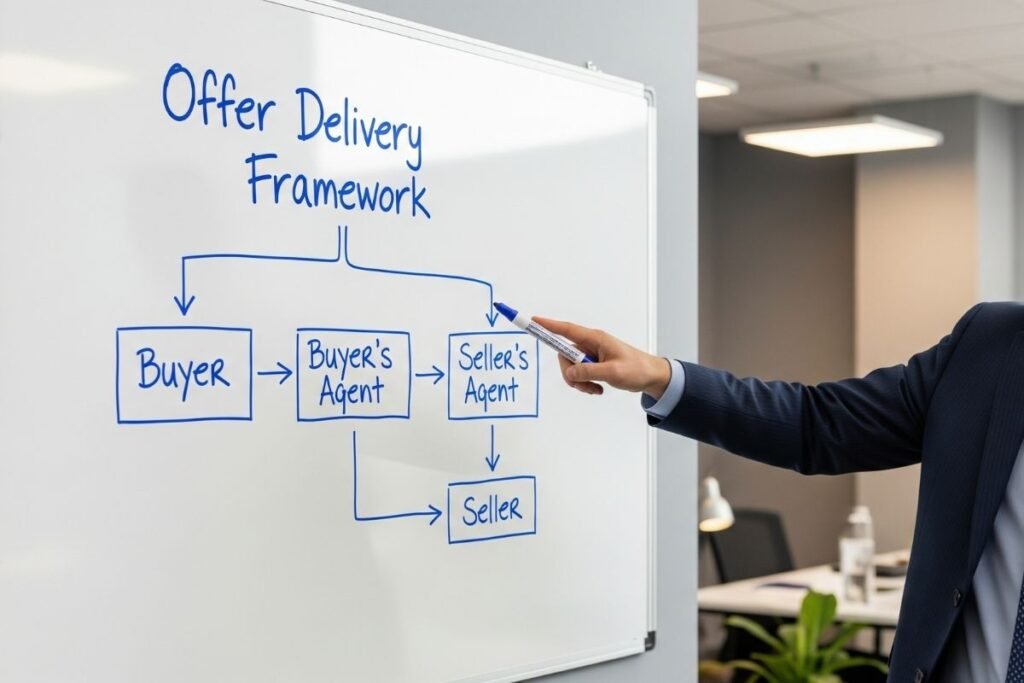If you’re buying a home, there comes an exciting and nerve wracking moment that you’ve found the one and you’re ready to make it yours. You sit with your agent, sign your offer and then wonder: Who delivers your offer to the seller framework in real estate?
This step isn’t just about sending an email or handing over papers. It’s part of a structured, legal and strategic process that ensures your offer reaches the seller in the right way, at the right time and with the right presentation.
Understanding this framework can remove a lot of the mystery from real estate transactions. Whether you’re buying your first home or your fifth, knowing who delivers your offer and how the process works can make you a more confident buyer and help avoid costly mistakes.
What is Offer to the Seller Framework in Real Estate? Basics

In real estate, delivering an offer means sending your official purchase proposal to the seller. This document outlines:
- The price you’re willing to pay
- Any conditions (like a home inspection or financing approval)
- Timelines for closing the deal
- Other agreed upon terms
But here’s the important part like you, the buyer, almost never deliver the offer directly to the seller in a traditional real estate transaction. Instead, there’s a professional pathway or framework, that keeps the process smooth, legal and fair.
Who’s Involved in the Framework?
- Buyer’s Agent: Prepares, explains and delivers your offer to the seller’s agent.
- Seller’s Agent (Listing Agent): Receives your offer and presents it to the seller.
- Seller: Reviews the offer and decides whether to accept, reject or counter.
This chain exists for a reason. It keeps emotions in check, ensures legal compliance and maintains professional communication throughout the process.
Why the Offer to the Seller Framework Exists

You might be thinking, Why can’t I just hand the offer to the seller myself? In some cases like For Sale By Owner (FSBO), you can. But in most traditional transactions, there are strong reasons to use the professional framework.
Legal Compliance
Real estate offers must follow state and local laws. Agents are trained to make sure your offer is written correctly, signed properly and meets all legal requirements.
Professional Presentation
Your agent knows how to package your offer so it looks organized and appealing. They’ll make sure it’s clear, complete and ready for the seller to review without confusion.
Confidentiality
Sensitive details like your financial situation or personal motivations are protected. Agents know what to share and what to keep private.
Negotiation Buffer
Direct buyer to seller negotiations can get emotional. Agents act as skilled go betweens to keep talks productive.
Speed and Efficiency
Because agents work with real estate documents daily, they know how to deliver offers quickly and securely often within hours.
The Step by Step Agent Led Framework

Here’s a clear breakdown of how the process usually works in an agent led transaction.
Step 1: Drafting Your Offer
You and your buyer’s agent sit down to discuss the terms such as purchase price, earnest money deposit, closing date and contingencies. The agent then prepares your offer using official real estate forms.
Example: You want to offer $350,000 on a home with a 30-day closing period and a financing contingency. Your agent fills out all the necessary sections, ensuring no detail is missed.
Step 2: Double Checking the Details
Before delivery, your agent reviews everything with you. Even a small typo can cause delays or confusion. This step ensures the seller gets a flawless document.
Step 3: Choosing the Delivery Method
Your agent decides, often with the seller’s agent, the best way to deliver the offer. This might be:
- Email with secure document attachments
- A real estate transaction platform (like Dotloop or DocuSign)
- In person delivery for urgent or sensitive offers
Step 4: Delivery to the Seller’s Agent
Your agent sends your offer directly to the seller’s agent. The listing agent has a legal duty to present the offer to their client quickly often the same day.
Step 5: Presentation to the Seller
The seller’s agent explains your offer, walking them through the numbers, conditions and timelines. They answer any questions and help the seller weigh their options.
Step 6: Seller’s Decision
The seller can:
- Accept the offer as is
- Reject it outright
- Counteroffer with new terms
Your agent then receives this decision and communicates it to you promptly.
Extra Tips for a Smooth Offer Process
Even though your agent does the heavy lifting, there are things you can do to make the delivery process more effective.
- Be Ready with Documents: Pre-approval letters, proof of funds and signed forms speed up the process.
- Respond Quickly: If your agent needs clarification, answer right away to avoid delays.
- Trust Their Experience: They’ve been through this process many times and know how to position your offer well.
- Stay Flexible: Sometimes quick adjustments like moving up your closing date that can make your offer more attractive.
Why Agent Delivery Matters in Competitive Markets

In a hot real estate market, timing and professionalism can make or break a deal. If your offer is delivered late, incomplete or without the right documentation, the seller might move on to another buyer.
Agents don’t just drop off your offer but actually they present it strategically. They might highlight your strong financing, minimal contingencies or flexibility with the seller’s preferred closing date. This presentation can give you an edge.
What Happens if You Don’t Use the Framework?
Skipping the agent led delivery process might sound faster, but it can create problems:
- Legal mistakes in the offer paperwork
- Miscommunication about terms or deadlines
- Emotional negotiations that lead to conflict
- Slower responses from the seller
The framework exists to keep things professional, legal and clear which benefits both buyers and sellers.
Conclusion
Knowing who delivers your offer to the seller framework in real estate takes away a lot of the guesswork from buying a home. In most transactions, your buyer’s agent prepares your offer, delivers it to the seller’s agent and ensures it reaches the seller quickly and professionally.
This process protects your interests, speeds up communication, and gives your offer the best possible chance of being accepted. When you work within the framework, you’re not just sending a piece of paper but you’re making a professional pitch for your future home.
FAQs
Who actually delivers my offer to the seller in real estate?
In traditional transactions, your buyer’s agent delivers the offer to the seller’s agent, who then presents it to the seller.
Can I give my offer directly to the seller?
Only in certain situations like For Sale By Owner (FSBO). In most cases, agents handle delivery.
How quickly should an offer be delivered?
Ideally within hours of signing. Speed is especially important in competitive markets.
What if the seller ignores my offer?
If there’s no response by the deadline in your offer, it simply expires. Your agent can advise you on next steps.
Is the offer binding once delivered?
It becomes binding only when the seller signs and acceptance is communicated to you or your agent.
Can I withdraw my offer after delivery?
Yes, as long as it hasn’t been accepted yet. Rules vary by state, so check with your agent.









